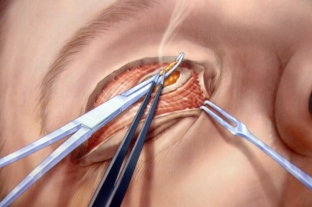Millions of women around the world spend a huge amount of money and time on the beauty of their eyes. It is this area of the face that first of all attracts attention during a conversation with a person. But some physiological processes cannot be stopped, and aging is one such process. Fortunately, in the modern world there are a huge number of methods for facial skin rejuvenation. And aesthetic surgery is one of the most effective and efficient ways to restore youth to the face and make it beautiful. One of the most requested operations in plastic surgery is upper blepharoplasty.
Upper blepharoplasty: features of the operation
Upper Blepharoplasty – This is a surgical intervention in which the surgical correction of the upper eyelid area is performed. According to the experts of the clinic Medical Club, where such operations are performed almost daily, blepharoplasty is one of the most frequently performed among the many aesthetic corrections. With age, under the influence of gravity, the layers of the face tend to fall, this also applies to the skin on the upper eyelid. Quite often, young people who have too heavy, overhanging eyelids apply for correction of this area. Upper blepharoplasty helps to eliminate such defects as effectively as possible.
Upper Blepharoplasty:
- what problems can be solved with upper blepharoplasty;
- sequence of steps for upper blepharoplasty;
- features of postoperative management of upper blepharoplasty.
What problems can be solved with upper blepharoplasty
The surgeons of the clinic Medical Club are sure that age-related changes in the upper eyelid area cannot be considered in isolation, which is why upper blepharoplasty as an independent surgical intervention is rarely performed. Often it is an addition to endoscopic fronto-temporal lifting, and helps to solve the following problems:
- removal of upper dermachalasis – excess skin on the upper eyelid;
- formation of a deeper palpebral sulcus;
- decrease in the volume of retroseptal tissue or elimination of the A-shaped retraction;
- correction of the position of the ciliary edge of the eyelid;
- weakening of the activity of the glabella muscles, lifting and fixation of the tails of the eyebrows, modeling of the upper-lateral edge of the orbit.
Sequence of steps for upper blepharoplasty
Incision marking for upper blepharoplasty is performed on the operating table, immediately prior to surgery. Three key points of the lower incision are determined along the central pupillary line, in the projection of the lateral angle of the eye, as well as the superior lacrimal opening. The distance from the incision to the lateral corner of the eye is often 5 mm; along the center line of the pupil – 9 mm., in the projection of the lacrimal opening also 5 mm. From the lateral point, the incision extends tangentially along one of the wrinkles to the lateral edge of the orbit. After that, in the position of closed eyelids, resection of excess skin, manipulations with the circular muscle and retroseptal fat, and suturing are performed.

Peculiarities of management of the postoperative period of upper blepharoplasty
The management of the postoperative period after upper blepharoplasty has its own characteristics. In standard situations, the specialists of the Medical Club clinic recommend the use of local agents that reduce tissue swelling, drugs that protect the cornea from drying out, and antibacterial drugs if necessary. Lymphatic drainage procedures are often used. Highly effective is local hypothermia in the first three days after surgery. On the third day after the operation, the sutures are removed, and the patient can already evaluate the effect. With proper performance of the upper blepharoplasty, it is possible to achieve the maximum aesthetic effect.







Add a comment